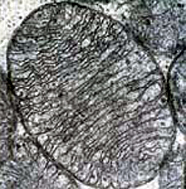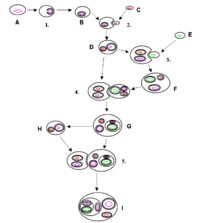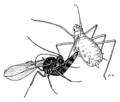Endosymbiosis facts for kids

Endosymbiosis is a cool way that living things work together. It happens when one organism, called a symbiont, lives inside the body or cells of another organism. This is very common in nature.
The word "endosymbiosis" comes from Greek words. "Endon" means "within." "Syn" means "together." "Biosis" means "living." So, it means "living together within."
Sometimes, both organisms help each other. For example, gutless marine worms called Riftia get food from tiny bacteria living inside them. The bacteria get a safe home. This kind of teamwork is called obligate endosymbiosis. It means neither the host nor the symbiont can live without the other. However, some endosymbioses can be harmful to one or both organisms.
Contents
How Organisms Live Together
Endosymbiosis can be either "obligate" or "facultative."
Obligate Endosymbiosis
In obligate endosymbiosis, the two organisms absolutely need each other to survive. They cannot live apart. The giant tube worms and their bacteria are a great example. If you separate them, both will die.
Facultative Endosymbiosis
Facultative endosymbiosis is different. Here, the organisms can live together, but they don't have to. They can survive on their own if needed. It's like having a friend you like to hang out with, but you can still have fun by yourself.
Cool Examples of Endosymbiosis
There are many amazing examples of endosymbiosis all around us.
Bacteria Helping Plants
- Rhizobia: These are nitrogen-fixing bacteria. They live in special bumps, called root nodules, on plants like peas. The bacteria help the plant get nitrogen from the air. This is important for the plant to grow.
Algae Living Inside Animals
- Forams: These are tiny, single-celled organisms. Some forams can take a single-celled alga inside their own cell. This is often "facultative," meaning they don't always do it.
- Idioplastic Endosymbiosis: A more unusual type is when a foram eats an alga but keeps its chloroplasts working. Chloroplasts are the parts that make food using sunlight. So, the foram uses the alga's food-making parts!
- Green Algae in Worms: Some green algae live inside marine polychaete worms.
- Algae in Corals: Single-celled algae live inside reef-building corals. These algae give the coral food, and the coral gives the algae a safe place to live. This is why coral reefs are so colorful and important!
Tiny Helpers in Digestion
- Gut Flora: Many insects and vertebrates (like us!) have tiny organisms, often flagellates, living in their digestive systems. These tiny helpers break down plant cellulose, which is a tough fiber. Without them, the host couldn't digest certain foods. These are usually "obligate" symbionts.
Fungi and Algae Team Up
- Lichen: A lichen is actually two organisms living together! It's a fungus and an alga (or sometimes a bacterium). They work together to survive in harsh places. The fungus provides protection, and the alga makes food.
- Mycorrhiza: This is another partnership between fungi and plants. Fungal hyphae (tiny threads) grow around or into the roots of trees. The fungus helps the tree get water and nutrients, and the tree gives the fungus sugars.
Images for kids
See also
 In Spanish: Endosimbionte para niños
In Spanish: Endosimbionte para niños





